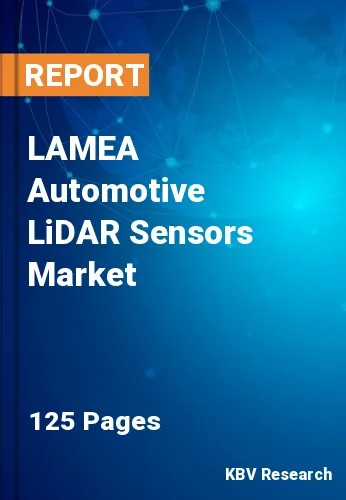
The Latin America, Middle East and Africa Automotive LiDAR Sensors Market would witness market growth of 35.7% CAGR during the forecast period (2023-2029).
Prominent companies and emerging businesses in the automotive LiDAR sector are prioritizing the improvement of LiDAR durability, performance, and range. Furthermore, market vendors are prioritizing the advancement of next-generation LiDAR sensors equipped with continuous-wave frequency modulation (CWFM) technologies, enabling the accurate determination of both target velocity and distance. In addition, CWFM LiDAR sensors offer immunity to background light and are not affected by other sources of light transmitting at the same frequency, unlike traditional LiDAR. Furthermore, the CWFM LiDAR sensor has the capability to measure both the speed and range of an object.
The projected increase in the need for automotive electronics is anticipated to drive the utilization of LiDAR sensors in the automotive industry. The adoption of automotive electronics, including clusters, thin-film transistors, lane departure warning cameras, and reverse & front parking cameras, is on the rise among end users. This factor is anticipated to generate growth prospects for stakeholders in the automotive LiDAR market.
Due to favorable conditions such as low import tariffs, low fuel costs, an equitable tax structure, and a high disposable income per capita, it is anticipated that the automobile industry in the region will continue to expand, particularly in the UAE. To facilitate the process of purchasing a vehicle for consumers, the UAE provides various insurance and financing options. The commercial prospects for luxury vehicles, electric and hybrid vehicles, and motorcycles are all extremely promising. Approximately 80% of the UAE's automotive industry is dedicated to the production of passenger automobiles, while the remaining 20% is devoted to the production of commercial vehicles such as trucks, vans, and buses. These aspects are expected to grow in the coming years.
The Brazil market dominated the LAMEA Automotive LiDAR Sensors Market by Country 2022, and would continue to be a dominant market till 2029; thereby, achieving a market value of $94.7 Million by 2029. The Argentina market is exhibiting a CAGR of 36.5% during (2023 - 2029). Additionally, The UAE market would showcase a CAGR of 35.4% during (2023 - 2029).
Based on Type, the market is segmented into Time of Flight (ToF), and Frequency-Modulated-Continuous-Wave (FMCW). Based on Technology, the market is segmented into Solid-state, and Electro-mechanical. Based on Vehicle Type, the market is segmented into Internal Combustion Engine (ICE), Hybrid, and Battery Electric. Based on Image Type, the market is segmented into 2 Dimensional, and 3 Dimensional. Based on Application, the market is segmented into Semi-autonomous Vehicles, and Autonomous Vehicles. Based on countries, the market is segmented into Brazil, Argentina, UAE, Saudi Arabia, South Africa, Nigeria, and Rest of LAMEA.
Free Valuable Insights: The Worldwide Automotive LiDAR Sensors Market is Projected to reach USD 5.3 Billion by 2029, at a CAGR of 32.1%
The market research report covers the analysis of key stake holders of the market. Key companies profiled in the report include Robert Bosch GmbH, Continental AG, Denso Corporation, Ouster, Inc., HELLA GmbH & Co. KGaA, First Sensor AG (TE Connectivity Ltd.), Texas Instruments, Inc., KUBOTA Corporation, Quanergy Systems, Inc. and LeddarTech Inc.
By Type
By Technology
By Vehicle Type
By Image Type
By Application
By Country
Our team of dedicated experts can provide you with attractive expansion opportunities for your business.
